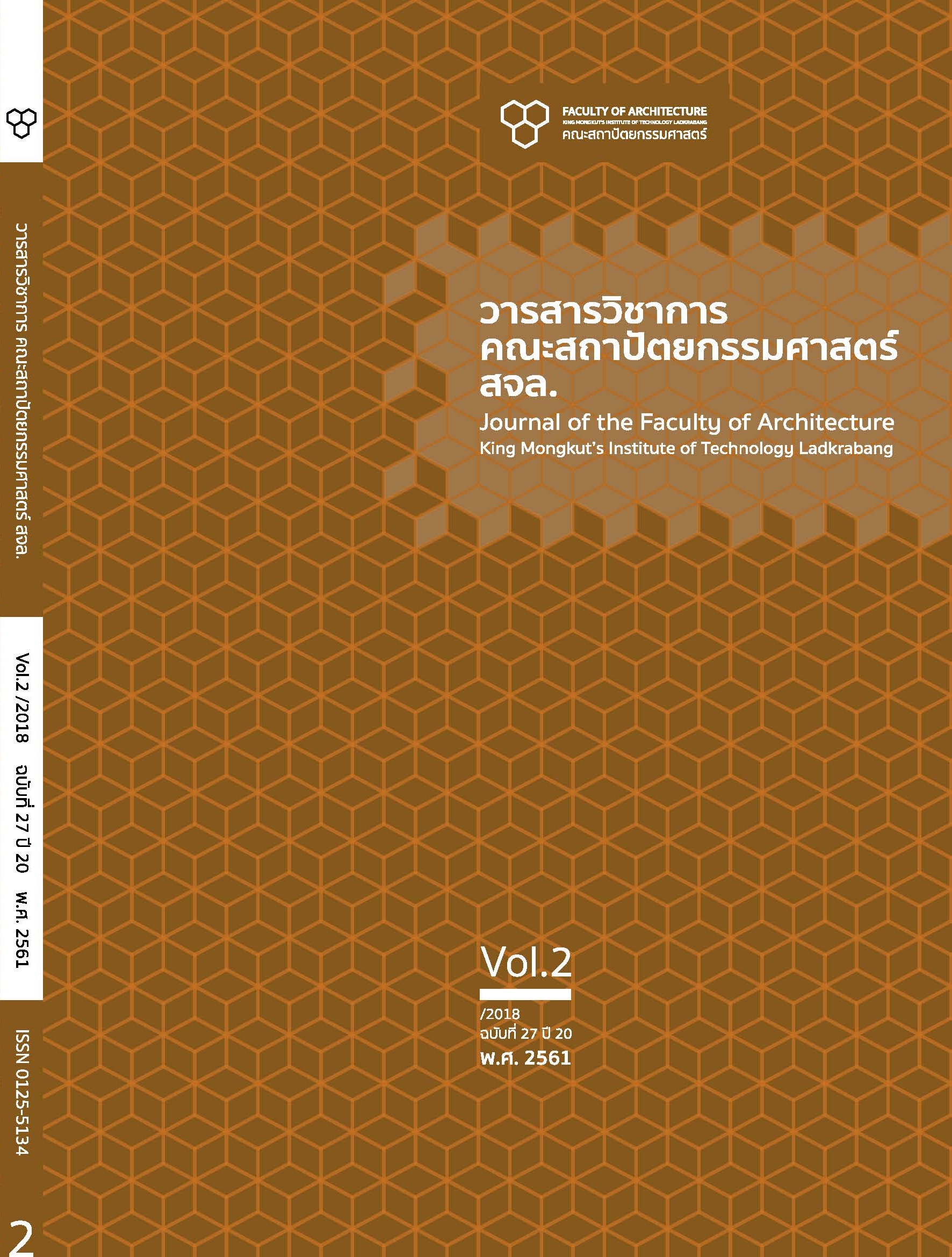ที่ดินบราวน์ฟิลด์ในเมืองเชียงใหม่ The Brownfield in Chiang Mai Municipality
Main Article Content
Abstract
บทคัดย่อ
บทความนี้มีวัตถุประสงค์ในการนำเสนอลักษณะของที่ดินบราวน์ฟิลด์ในเขตเทศบาลนครของจังหวัดเชียงใหม่ เพื่อเป็นกรณีศึกษาโดยที่ดินบราวน์ฟิลด์ในประเทศไทยนั้นเริ่มปรากฏให้เห็นในเมืองใหญ่ ๆ ทั่วประเทศ เช่นเดียวกับที่ดินบราวน์ฟิลด์ในจังหวัดเชียงใหม่ ซึ่งจากผลการศึกษาในเขตเทศบาลนครเชียงใหม่ ซึ่งมีพื้นที่ 40.216 ตร.กม หรือ 252,707 ไร่ พบว่า มีพื้นที่ดินบราวน์ฟิลด์ทั้งหมด 585.96 ไร่ คิดเป็นร้อยละ 2.23 ของพื้นที่ทั้งหมด ซึ่งส่วนใหญ่ จะเป็นพื้นที่ดินบราวน์ฟิลด์ ที่เคยใช้ประโยชน์เป็นที่ดินประเภทพาณิชยกรรมมาก่อน เช่น อาคารพาณิชย์ หมู่บ้านจัดสรร และสถานบริการ ซึ่งตั้งอยู่ในพื้นที่ทางด้านทิศเหนือและทิศตะวันออกของเมืองที่เป็นย่านการค้าและย่านเศรษฐกิจเก่าของเมือง มีพื้นที่ประมาณ 412.74 ไร่ คิดเป็นร้อยละ 70.44 ของพื้นที่บราวน์ฟิลด์ทั้งหมด รองลงมาคือที่ดินบราวน์ฟิลด์ อุตสาหกรรม และเกษตรกรรมตามลำดับ ทั้งนี้พื้นที่ดังกล่าวมีศักยภาพและสามารถนำพื้นที่บราวน์ฟิลด์ดังกล่าวมาพัฒนา ให้เกิดประโยชน์แก่เมืองเชียงใหม่ได้ โดยนอกเหนือจากการนำพื้นที่บราวน์ฟิลด์มาใช้ประโยชน์ในเชิงพาณิชยกรรมอีกครั้ง ยังสามารถนำมาพัฒนาเป็นพื้นที่สีเขียวได้ ซึ่งแนวทางดังกล่าวจะช่วยเพิ่มปริมาณพื้นที่สีเขียวในเขตเทศบาลนครเชียงใหม่ ซึ่งแต่เดิมมีสัดส่วนพื้นที่สีเขียวต่อคนในระดับที่ต่ำกว่ามาตรฐาน โดยมีพื้นที่เพียง 5.54 ตารางเมตรต่อคน จากค่ามาตรฐาน 12 ตารางเมตรต่อคน เป็น 13.12 ตารางเมตรต่อคน ซึ่งจะเพิ่มขึ้นมากถึงกว่าร้อยละ 54 นั่นเอง
คำสำคัญ: ที่ดินบราวน์ฟิลด์ การฟื้นฟูสิ่งแวดล้อม การพัฒนาเมือง และพื้นที่สีเขียว
Abstract
This paper focuses on presenting characteristic of brownfield area using the case study of Chiang Mai Municipality. Brownfield in Thailand begins to appear in big cities all over the country. In Chiang Mai municipality with the total area of 40.216 Sq.km or 252,707 Rai. Brownfield is found to cover over the area of 585.96 Rai or 2.23% from the total area. Mostly, the brownfield was used for commercial purposes such as commercial real estate, village and entertainment venue which located to the north and the east of former commercial and economic district of the city with area covers approximately 412.74 Rai or 70.44% of the total brownfield area. The industrial and agricultural brownfield area are the second and third common types respectively. The discovered brownfield signifies potential land that could develop to benefit Chiang Mai Province as a whole. Apart from redevelop it into its former function as commercial uses, turning this potential brownfield into greenfield area is another option worth consideration. By doing so will increase the green area in Chiang Mai which is currently only 5.54 square metres from the required standard of 12 square metres per person. The transformation from brownfield to green area will increase the rate of green area per person by 54%. or 13.12 square metres per person.
Keywords: Brownfield, Environmental Rehabilitation, Urban Development and Green Space 1-2
Article Details
This work is licensed under a Creative Commons Attribution-NonCommercial-ShareAlike 4.0 International License.
Copyright Transfer Statement
The copyright of this article is transferred to Journal of The Faculty of Architecture King Mongkut's Institute of Technology Ladkrabang with effect if and when the article is accepted for publication. The copyright transfer covers the exclusive right to reproduce and distribute the article, including reprints, translations, photographic reproductions, electronic form (offline, online) or any other reproductions of similar nature.
The author warrants that this contribution is original and that he/she has full power to make this grant. The author signs for and accepts responsibility for releasing this material on behalf of any and all co-authors.
References
ราชบัณฑิตยสถาน. (2553). ศัพท์ผังเมือง อังกฤษ-ไทย ไทย-อังกฤษ ฉบับราชบัณฑิตยสถาน. กรุงเทพฯ: ราชบัณฑิตยสถาน. สฤษดิ์ ติยะวงศ์สุวรรณ. (2555). การพัฒนาที่ดินบราวน์ฟิลด์. วารสารวิชาการคณะสถาปัตยกรรมศาสตร์. สถาบันเทคโนโลยีพระจอมเกล้าเจ้าคุณทหารลาดกระบัง. 14(1), 137-147.
สานักงานนโยบายและแผนทรัพยากรธรรมชาติและสิ่งแวดล้อม. (2547). รายงานฉบับสมบูรณ์: โครงการจัดทำมาตรการในการเพิ่มและการจัดการพื้นที่สีเขียวในเขตชุมชนอย่างยั่งยืน. กรุงเทพฯ: ศูนย์วิจัยป่าไม้ คณะวนศาสตร์ มหาวิทยาลัยเกษตรศาสตร์.
Environmental Studies Capstone (ESC). (2009). Brownfields Remediation. Seminar Spring 2009. Delaware County: Swarthmore College. Grimski, D. and Ferber, U. (2001). Urban Brownfield in Europe. Land Contamination & Reclamation, 9 (1), 143-148.
Siebielec, G. (Ed.). (2012). Brownfield redevelopment as an alternative to greenfield consumption in urban development in Central Europe. Czartoryskich: Institute of soil and plant cultivation State Research Institute.
Kühl, K. (2010). From Brownfields to Greenfields: A Field Guide to Phytoremediation. เข้าถึงได้จาก: https:// urbanomnibus.net/2010/11/from-brownfields-to-greenfields-a-field-guide-to-phytoremediation/.

